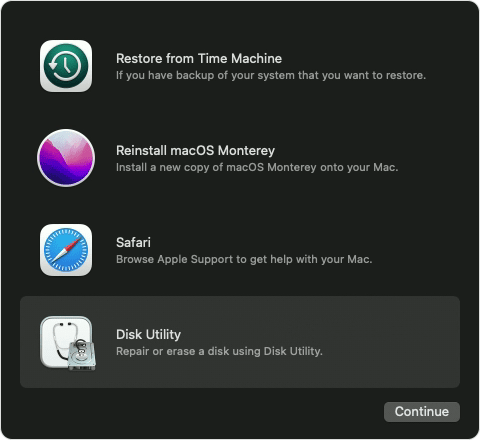How to repair a Mac storage device with Disk Utility
Disk Utility can find and repair errors related to the formatting and directory structure of a Mac storage device. Errors can lead to unexpected behaviour when you're using your Mac, and significant errors may even prevent your Mac from starting up completely.
Before you begin
Make sure you have a current backup of your data, in case you need to recover damaged files or Disk Utility finds errors that it can't repair.
Open Disk Utility
If you’re repairing your Mac startup disk or your Mac doesn’t start up all the way, start up from macOS Recovery. When you see the list of utilities in Recovery, select Disk Utility, then click Continue.
Disk Utility is also available in the Utilities folder of your Applications folder.

Use First Aid in Disk Utility
From the menu bar or toolbar in Disk Utility, choose View > Show All Devices (if available).

The sidebar in Disk Utility now shows each available storage device, beginning with your startup disk. Listed under each device are any containers and volumes on that device. Don't see your device?
In the following example, the startup disk (APPLE SSD) has one container (Container disk4) and two volumes (Macintosh HD, Macintosh HD - Data). Your disk may not have a container, and it may have a different number of volumes.

For each device that you're repairing, start by selecting the last volume on that device. In the example above, Macintosh HD - Data is the last volume.
Click the or tab, then click Run (or Repair Disk) to begin checking the selected volume for errors. If the button is dimmed and you can't click it, skip this step for the disk, container or volume you selected. If asked for a password to unlock the disk, enter your administrator password.

After Disk Utility is done checking the volume, select the next item above it in the sidebar, then run First Aid again. Keep moving up the list, running First Aid for each volume on the device, then each container, then finally the device itself.

When it's finished, exit Disk Utility. If you used Disk Utility from macOS Recovery, you can now restart your Mac: from the Apple menu , choose Restart.
If Disk Utility can’t repair or see your device
If Disk Utility found errors that it can't repair, use Disk Utility to erase (format) the disk.
If your storage device doesn’t appear in the sidebar of Disk Utility, your Mac or the storage device may need service. Shut down your Mac and unplug all non-essential devices, then try again. For an external storage device, check its cable, connections and power as well.
